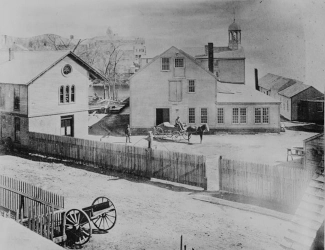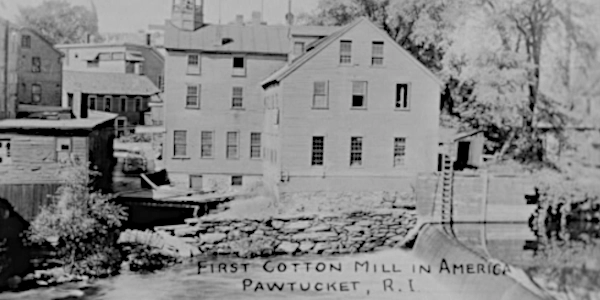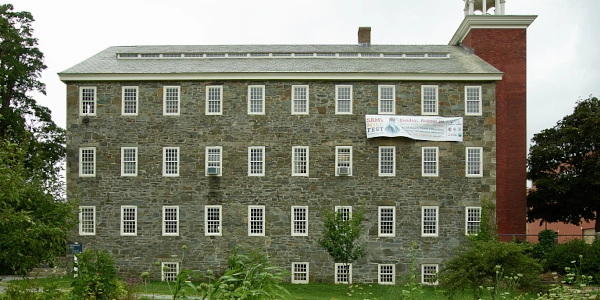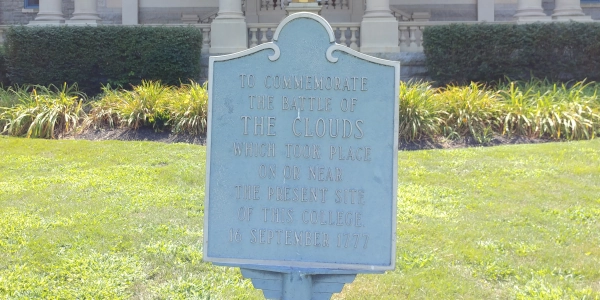
Image above: Slater Mill Complex from north elevation, 1870, Historic American Buildings Survey. Courtesy Library of Congress.
Spotlight on Lesser Known History
Slater Mill, Rhode Island
America's Best History Spotlight
On this page we're going to Spotlight the lesser known historic sites and attractions that dot the history landscape across the USA and are worth a visit if you're in their area. And while they may be lesser known, some are very unique, and will be that rare find. You'll be, at times, on the ground floor, or maybe even know something others don't. It'll be fun. Visit them.

Slater Mill, Blackstone River Valley NHS, Pawtucket, Rhode Island
There's the backstory about Sam Slater and his forethought to build the first water-powered cotton mill in the United States along the Blackstone River in Pawtucket, Rhode Island in 1793. Then there's the famous story of the first women's strike at that same mill in 1824. There's the story of the expansion of that mill and others in the town such as the Wilkerson Mill next door, and now the story about how you can visit all that within the Blackstone River Valley National Historic Site, which includes even more. So if you wend your way toward Pawtucket some day, take in history, industrial revolution style, even as it had barely gotten started. Image above: Slater Mill at the Blackstone River Valley National Historic Site, Pawtucket, 2018, Carol M. Highsmith. Courtesy Library of Congress.
Sponsor this page for $100 per year. Your banner or text ad can fill the space above.
Click here to Sponsor the page and how to reserve your ad.
Info, What's There Now, History Nearby

Slater Mill, Rhode Island
The Industrial Revolution, it is said, started right there, as Sam Slater built his dam and mill in 1793 along the Blackstone River, against many opinions in town. It started a boom of similar mills through the next fifty years, spurred by government policy. The Embargo of 1809 and the Tariff of 1816 assisted United States textiles against imports from Great Britain.
However, the Slater Mill and others were renowned for their long working hours and use of child labor. They also hired entire families and required them to buy their goods from the company store. Today, you can see the mill, plus other industrial revolution sites, all part of Blackstone River National Historic Site.
Image above: Postcard called, "The First Cotton Mill in America, Pawtucket, Rhode Islands," 1922, Historic American Buildings Survey. Courtesy Library of Congress. Below: Wilkerson Mill at the Blackstone River Valley National Historic Site, 2018, Carol M. Highsmith. Courtesy Library of Congress.

Where Is It
Blackstone River Valley National Historical Site includes the Slater Mill and other disparate sites, much of them still in the completion phase per National Park Service use as the site has only been a National Historic Site since 2014. The Visitor Center/Park Headquarters is located at 67 Roosevelt Avenue, Pawtucket, Rhode Island 02860, in the Wilkerson Mill, where you can get orientation to the Slater Mill and other sites within the NHS.
What is There Now
Slater Mill
Blackstone River Valley National Historic Site includes the original Slater Mill and park headquarters inside the Wilkerson Mill next door. While the grounds are open daily; the Slater Mill is currently only open on Fridays and Saturdays with summer hours in 2022 expanded to Thursday through Sunday for guided tours. It is also closed in winter months. There are self-guided walking tours of the other sections with some ranger walk-abouts depending on staff at some parts of the park.
When Open and How Much
The various units of the park are open different hours; please check the website or call ahead on the day of your visit to see just what's going on. There is no charge for the National Park Service run sections; however, some partners do charge a small admission fee at their sites.
Fees subject to change.
Websites
Blackstone River Valley National Historic Site
History Nearby
It's a New England pleasure gound of historic sites of Revolutionary War fame to natural landscapes from the Atlantic Ocean to inland treasures.
Buy Chronology

Great Book for the History Fan with Fifty Short Essays Telling the Story of American History.
Photos, History, and More Spotlights

First Strike by Female Workers
It was May 24, 1824, and the Slater Mill in Pawtucket, Rhode Island was working their employees hard, timing their work to the minute, factory bells, a company store, and then, they offered the female employees a twenty-five percent wage cut and an extra hour per week of work. That did not go over well. One hundred and two women walked out on strike, vowing not to return until their wages were restored. Women between the ages of 15 and 30 had been working at the mills for several years after the introduction of the power loom.
The walk-out expanded to include children and some men, plus other townspeople. It then moved through the other eight mills in the town. In total, around five hundred workers were striking. Doors were blocked so other workers could not enter. Rocks and insults were tossed at the mill owner's houses, much of that done by the farmers in the area who provided the raw material. The fight between the townspeople had started at the inception of the mills, who blocked up the river with dams, and wanted all public improvements to be pushed in their direction.
"On Wednesday evening a tumultuous crowd filled the streets, led by the most unprincipled and disorderly part of the village, and made an excessive noise - they visited successively the houses of the manufacturers, shouting, exclaiming and using every imaginable term of abuse and insult. The window in the yellow mill was broken in. ... The next day the manufacturers shut their gates and the mills have not run since," Pawtucket Journal.
But the owners were not prepared to be shutting their gates for long. After one of the mills was destroyed, the owners caved within one week, on June 3, 1824, with almost all of the wages restored. The particulars are not known. But this first strike led by female laborers was the first in the United States; it would not be the last.
Photo above: Slater Mill in steroscope photo, 1927, Keystone View Company. Courtesy Library of Congress. Source: "Labor History: The First Factory Strike, ... in 1824 in Pawtucket, R.I., women weavers led the mother of all strikes," 2014, Joey L. DeFrancesco and David Segal, inthesetimes.com; New England Historical Society.

Slater Mill History
Credit for the inception of the Industrial Revolution in America often goes to Sam Slater, whose cotton mill on the Blackstone River in 1793 got the ball rolling for other industrialists. He was a typical mill owner prior to Union organization, hiring the cheapest labor he could find. Who was that? Try children, ages seven to thirteen. How long were they required to work? Twelve hours per day, six days a week, in the winter, sixteen hour days, six days per week, in the summer.
Did they get paid well? You already know that answer. No. Forty to sixty cents per week.
Slater and other mill owners would have continued to use child labor after 1810, but the requirements of the power loom required more sophisticated minds. So they hired young women 15 to 30, who could do the work well.
They were, however, less easy to persuade that dropping their wages was for their own benefit.
Photo above: Slater Mill from the southeast, 1991, Joseph E.B. Elliot. Courtesy Historic American Buildings Survey, Library of Congress.

T-Shirts and Gifts from the official souvenirs of Americasbesthistory.com.

Blackstone River Valley NHS
Established by President Obama in 2014, the Blackstone River Valley NHS was meant to tell the history of how the industrial revolution in America started around the nature that was available to power its machines. Whether that be, at first, a waterwheel, or later a power loom, or other devices needed to accomplish their goals.
The park itself has Visitor Centers at many different sites, some run by partners of the National Park Service, coordinated during its era as a National Heritage corridor. They are located at the Old Slater Mill National Historic Landmark District, Blackstone River State Park, Ashton Historic District, Slatersville Historic District, Whitinsville Historic District,
Hopedale Village Historic District, Blackstone River and the tributaries of Blackstone River, and the Blackstone Canal.
Some of these units are widespread, even into Massachusetts.
Photo above: Wilkerson Mill on the left with Slater Mill in distance, 1991, Joseph E.B. Elliot. Courtesy Historic American Buildings Survey, Library of Congress.
About
America's Best History where we take a look at the timeline of American History and the historic sites and national parks that hold that history within their lands.
Photos courtesy of the Library of Congress, National Archives, National Park Service, americasbesthistory.com and its licensors.
- Contact Us
- About
- © 2022 Americasbesthistory.com.
Template by w3layouts.


